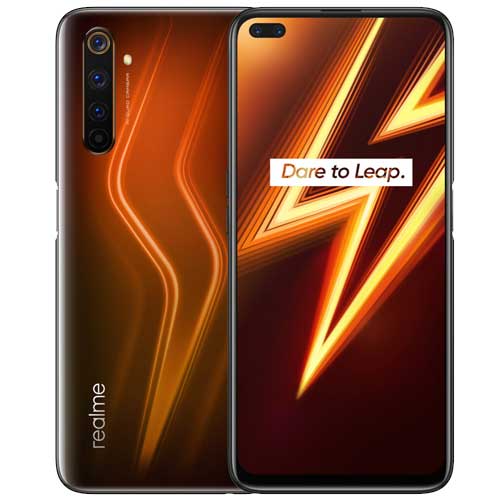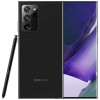Realme 6 series consists of two phones: Realme 6 and Realme 6 Pro, 6 Pro Phone is a new expert who needs to revise the brand's “product portfolio”. However, the Realme 6 Pro cannot be considered the successor to the Realme 5 Pro due to its high price tag. Thus, it can be the heir to the title of the series. We have been using the device for a while and this is what we think.
Design: A bit of old & a bit of new addition- I have been fond of Realme designs to date, but I didn’t find the Realme 6 Pro that appealing.
The Realme 6 Pro has two colors to choose from: Lightning Blue and Lightning Orange. Our review unit was the Lightning Blue colour model.The smartphone boasts of a new lightning bolt design on the rear side which resembles a lightning flash in the sky. The design comes out best in the Lightning Orange colour variant.Moving On, the Realme 6 Pro not only has an uber-cool back panel with a lightning bolt optical effect, it's also made of glass,in contrast to the realme pro which has a plastic black & which is a lot more resistant to scratches. However,scratch protection was not mentioned. Unlike the Realme XT and X2, Corning Gorilla Glass is screen limited. But after two weeks of testing, my back didn't get scratched. While not ideal, Lightning Blue is capable of hiding fingerprints and smudges. Realme 6 Pro joins that bandwagon with a large 6.6-inch screen, over 9 mm thickness, and a weight close to 200 grams despite a plastic frame and feels bulky in hand even without a cover.This phone could have easily been more compact, slimmer and lighter, without missing out on a single feature.The handset has a quad-camera set up aligned vertically at the top left side with the LED flash placed beside.
The camera module is slightly protruding, so wobble and shake slightly. The company identification can be found in the lower left corner of the back.This phone can accommodate 2 nano 4G SIM cards and a dedicated micro SD card in the leftmost card. The volume button is slightly lower. The power switch is on the right edge and also doubles as a fingerprint reader. It sounds cool on his face, but it isn't. The location of the scanner is not an issue as you can easily access the scanner with your thumb while holding the phone. There is a problem with the power switch. The phone never locks accidentally when someone tries to check the lock screen notification. However, the scanner responds very quickly and unlocks the phone as often as possible before the power button is fully pressed. So, to check the lock screen, you need to press the button with another finger that is not displayed on the scanner. Too much gymnastics and irritation after a while. A small gap in the center of the screen still seems like the best position for the front camera. However, this is a matter of personal preference. The bottom of the phone houses the USB Type-C port, 3.5mm audio jack, and speaker grill.
Display: A screen with 90 Hz refresh rate-
Unlike Super AMOLED from some of the siblings available on this budget, the company opted for this mobile LCD screen. The pixel density provides less than 400 PPI shadows, but the 6.6-inch Full HD screen with 2400 x 1080 pixels is very sharp. The black level and contrast are not as good as the AMOLED screen of the Realme XT, but the difference in quality is not that good. More importantly, color is a matter of money, and colors look natural. The display also houses the punch-hole dual front cameras placed at the top-left.We had no complaints with the viewing angles or colour reproduction with Realme 6 Pro. The only negative here is the brightness level of Realme 6 Pro which we think is lower and inadequate, especially to use in daylight. Reality is about 480 nits of screen brightness, so it doesn't seem too visible. An important feature here is the 90Hz refresh rate and there is no flickering when scrolling through compatible apps. Scrolling through social media and feed content looks smoother than on a regular screen. But don't expect the 90Hz benefits to spill over into gaming.The screen is protected by a layer of Corning Gorilla Glass 5. On the flipside, the screen feels a bit too big and one-handed operation is out of the question. But those who like big screens won’t be complaining. The camera cutout on the screen can be a bit of a distraction initially and takes a while getting used to.
Performance:
We all know by now that the Realme 6 Pro is powered by Qualcomm’s new Snapdragon 720G SoC. They made sure we know. The 720G is supposed to be a slightly scaled-down version of the Snapdragon 730G used in the Realme X2 and Poco X2.
It is an Octa-core chip with two Kryo 465 Gold cores running at 2.3 GHz each and six Kryo 465 Silver cores running at 1.8 GHz. The 730G uses bit more powerful Kryo 470 cores. However, both chipsets use the same Adreno 618 GPU, which is good news for gamers. There are no delays in daily work or switching between several applications running at the same time. My test unit has 8 GB of RAM, but I don't think there is actually a difference even with the 6 GB RAM version. In terms of performance, the Mediatek Helio G90T and Snapdragon 730G have impressive results (the difference is very small). On Geekbench 5, it scored a single-core score of 571 versus 498 on the Redmi Note 8 Pro (with G90T).
The multi-core score of 1699 is almost 10% higher than Redmi's 1552. The G90T itself is a pretty powerful chip that delivers 10% more system performance - a remarkable achievement for 720G. However, the scene in the graph is slightly different. The Snapdragon 720G cannot outperform the OpenCL G90T on Geekbench 5.It managed to score 1,167 which is a marked improvement over hte 936 on the Snapdragon 712 chip in the Realme XT/5 Pro, but nowhere near 1,827 that the Helio G90T chip could manage. In 3DMark Sling Shot Extreme-Vulkan, the Adreno 618 GPUs are located close to each other at 2345 points, but they cannot exceed the 2412 points defined for the MC4-GPU Mali-G76 (G90T). Overall, the cheaper Realme 6 also uses the Helio G90T SoC, which is theoretically a better alternative for gamers than the 6 Pro based on the results of this test. This is an all-encompassing standard and should only be seen as a guideline and not the word of God.
To test the performance of the game in the real world, I tried PUBG Mobile with very high settings. You can enjoy playing smoothly without hiccups. The same applies to asphalt 9. The phone does not heat up even after 15-20 minutes of playing, which is another added advantage. Realme 6 Pro is perfect for game lovers on a budget.Call quality is good with nothing unusual to report. The phone can deliver hi-res audio that is Dolby Atmos compliant. Unfortunately, I did not have any high-end earphones handy to delve deeper into the audio department. The phone speaker is pretty loud with more than decent clarity.

The cameras of the Realme 6 Pro are sufficient for this segment and deliver clear photos in most conditions. The rear camera bay consists of four cameras, consisting of a main 64MP camera, a 12MP telephoto lens with dual optical zoom, an 8MP ultra-wide camera, and a 2MP micro-camera. As you can see, there is no separate depth sensor here, so that's a good thing. In this era, it is almost over the top. The camera by default allows you to take pictures in standard mode, 64-megapixel in standard mode and 16-megapixel in pixel binning if necessary.
The 64 MP mode does not significantly increase compared to the standard mode. However, you can use it to print the captured image or crop a specific part of the image. However, you have to deal with a file size 3-4 times larger (over 20MB) per image. The quality of the captured image in standard mode is bright, but it is good enough with natural colors and sufficient detail. Noise level in good condition. HDR works well here and is best left on silent.
The camera app allows you to choose between normal zoom, very wide, 2x and 5x. You can switch standard photo, video, night, portrait and 64MP modes. Macro mode is available in other variants. Portrait mode works well for distinguishing between foreground and background. You can also manually adjust the blur level using the camera app. Paintings are good for people or other objects. Interestingly, Standard Photo Mode automatically blurs the background in certain scenarios.
Like most mid-range phones, 8MP ultra wide angle cameras don't really burn the world. It's a good choice when you need a wider field of view, but the details you take are not close to the main camera. Photos taken in bright light retain adequate detail, but when the light falls, quality deteriorates quickly. 2x mode provides optical zoom, while 5x mode is mainly hybrid / digital zoom. Pictures taken at 2x magnification are clearly reproduced. Oddly enough, photos taken at 5x magnification in bright conditions look pretty good on a mobile phone screen if you want to use them on social media. This requires a very stable arm or tripod. The phone also has a 20x hybrid zoom.
The 2 MP macro camera has been around on Realme phones since the Realme 5 series. Captured images are strictly OK at best, with average details. You cannot really expect miracles from a 2 MP camera. That is one mode I would like to see evolving on phones this year. Redmi has bumped it up to 5 MP on their Note 9 series.
Even if you don't enable Night Mode, the Realme 6 Pro's low-light shooting really suits this segment. The picture is very clear and saves a lot of detail in many cases. Sometimes, especially when focusing on the closest subject, various focusing problems arise. Night mode works well too, and it makes the photos look brighter without exaggeration. For best results, remain silent for a few seconds when using Night Mode. And there is no need to turn on the LED flash. Selfie lovers will love this phone's front camera. A combination of 16MP (wide) and 8MP (ultra wide) is available, and you can easily switch between them with just one touch. The captured image is clear and skin color appears natural. Super wide angle cameras are very useful when taking group selfies. The front camera captures high quality portraits with excellent background resolution. You can also record 1080p videos in Full resolution.
Video Performance: Not so good According to budget-
The rear camera of the Realme 6 Pro is capable of recording 30fps video at 4K resolution and 1080p video at 30fps at 60fps. The recorded 4K image looks sharp, but there is no stabilization. 1080p video recorded by the main camera also looks very sharp and has electronic image stabilization. With this phone, you can take pictures with a wide-angle telephoto lens (only in good light). For best results, use the main camera.
Battery life: Better backup & even better fast charger-
The Realme 6 Pro has a 4,300mAh non-removable battery, which allows you to use it for a day and a half. This includes using rich messaging and social networking apps, viewing, clicking multiple photos, watching videos and playing games every 30 minutes. I would argue that this is more than just battery life. An internal charger is better. The company has a 30W VOOC 4.0 charger that can charge your phone from 0 to 100% in 65 minutes. It's as good as it is in this segment. The 4000mAh Realme XT battery runs from 0 to 100% in about 87 minutes with a VOOC charger connected to this phone. Even if the battery of the Realme 6 Pro has a larger battery, it consumes 25% less. Well done!
Operating System and User Interface: Clean UI, but with pre-installed bloatware-
Realme 6 Pro works directly with Android 10 with Realme UI 1.0 above. This was recently updated with a security patch in March 2020. It's not much different from Color OS 6 you find on older Realme phones. It's just the next iteration, and it's a little more complicated. This is one of the best phone user interfaces. Very clean, fast and easy to use and you can apply for a box. If you've used Android UI before, you can quickly adapt to Realme UI. One problem, however, is that there is too much software in the phone. Luckily, you can remove most of the notifications and block many unwanted ones. During testing, I saw no annoying ads, except for a few in standard browsers. I can't uninstall the browser, but I already have Chrome installed on this headset, so I don't need to use it.
Value for money:
All have been said and done,bt the question is the Realme 6 Pro worth your hard earned money? Now,I'm going to answer this on my perspective.
Firstly, as a standalone device using the Realme 6 Pro, it is not that bad or disappointing for most buyers. It has competent hardware, a clear screen, a good camera, an excellent battery, a relatively clean user interface, and a reasonable price. What else can a middle class phone ring? Ironically, this is one of the many companies raising consumer expectations in this budget.
Secondly,The Realme 6 Pro may be great, but there are others that can be purchased for the same price and bought from Realme. There is a Realme X2 with similar features, a more powerful Snapdragon 730G SoC screen, and a Super AMOLED screen, but the refresh rate is 90Hz. The Poco X2 Competition Camp offers a 90Hz screen and one or more screens.
However, the biggest threat came from his brother Realme 6, which offered almost all Pro versions (including Mediatek Helio G90T chips) at a low price. The only thing I can tell you about the aforementioned three phones is the 2x optical zoom. This is not an important factor for most buyers. So the Realme 6 Pro is a good phone, but it's worth standing out from the crowd and creating your niche. Realme's strategy can fall prey to transferring too many phones too often. But even if you buy this phone, you won't be disappointed (especially the 6GB RAM / 128GB storage). However, the Realme 6 (for non-professionals) would be a smarter buy as it delivers more value without losing important features.
Final words on Realme 6 Pro: Should I Buy It?
The Realme 6 Pro offers pretty much everything the company promises. The hardware is well built and easy to see. Besides the volume button, the design actually differs from the price. In particular, if you connect the ratio to a 90Hz screen, the interior will be smoothed out. camera You can hit or pass the camera. The base camera delivers satisfactory images, but ultra-wide and telephoto lenses don't always provide lighting and white balance. However, the front camera makes the Realme 6 Pro fun for selfie photographers. Realme 6 Pro is very easy to justify and recommend for the price. Overall, the Realme 6 Pro lives up to most of the prices. If the Snapdragon 730G chipset is faster, this phone will be the winner in the category, but that's a small mistake. This phone is highly recommended for almost anyone looking for a new mid-range ranger.


 The Samsung Galaxy Note series has always been the smartphone of most professionals, myself included. I was originally connected and haven't been able to walk since then. With Note devices, you feel like you can do whatever matters. And that's the feeling I got again after holding the Samsung Galaxy Note 20 Ultra 5G in my hand. But worth Rs 1 Lakh+ money, is this phone worth it? Read the review for
The Samsung Galaxy Note series has always been the smartphone of most professionals, myself included. I was originally connected and haven't been able to walk since then. With Note devices, you feel like you can do whatever matters. And that's the feeling I got again after holding the Samsung Galaxy Note 20 Ultra 5G in my hand. But worth Rs 1 Lakh+ money, is this phone worth it? Read the review for Vivo has recently launched a mid-range segment in August 2020. And It's a Y-series(20) smartphone. Before this Y20,Vivo has already launched a lot of Y series phone at a very affordable price such as Y50, Y11, Y90 etc. This time we are going to see what new or special features Vivo has added. With Vivo Y20, Vivo also has launched another model of Y series that is named Y20i. This two phones
Vivo has recently launched a mid-range segment in August 2020. And It's a Y-series(20) smartphone. Before this Y20,Vivo has already launched a lot of Y series phone at a very affordable price such as Y50, Y11, Y90 etc. This time we are going to see what new or special features Vivo has added. With Vivo Y20, Vivo also has launched another model of Y series that is named Y20i. This two phones Tecno's popular series of smartphones 'Tecno Spark 6 Air' has been launched in Bangladesh which is a low budget phone. Officially, the sale of the phone has already started in the market. The last few days I have been using this phone. And I have found the similarity of the Tecno Pouvier 4 with the phone in use. The key is to buy the phone that will attract the buyers. But the
Tecno's popular series of smartphones 'Tecno Spark 6 Air' has been launched in Bangladesh which is a low budget phone. Officially, the sale of the phone has already started in the market. The last few days I have been using this phone. And I have found the similarity of the Tecno Pouvier 4 with the phone in use. The key is to buy the phone that will attract the buyers. But the Technological advances are making cell phones smarter every day. But the price went up too! If you want to buy a smartphone at an affordable price with modern features, don't miss to check out the realme 7 series! Recently, Realme has launched a new smartphone in its Realme 7 series - the Realme 7i. The new budget Realme smartphone joins the Realme 7 and the Realme 7 Pro devices that were launched
Technological advances are making cell phones smarter every day. But the price went up too! If you want to buy a smartphone at an affordable price with modern features, don't miss to check out the realme 7 series! Recently, Realme has launched a new smartphone in its Realme 7 series - the Realme 7i. The new budget Realme smartphone joins the Realme 7 and the Realme 7 Pro devices that were launched Technological advances are making cell phones smarter every day. But the price went up too! If you want to buy a smartphone at an affordable price with modern features, don't miss the Realme C series! Having opened in the local market in Bangladesh in February 2020 with the launch of realme C2, the pioneering realme brand surprised us with a wide range of high-end phones at a reasonable price range. In this
Technological advances are making cell phones smarter every day. But the price went up too! If you want to buy a smartphone at an affordable price with modern features, don't miss the Realme C series! Having opened in the local market in Bangladesh in February 2020 with the launch of realme C2, the pioneering realme brand surprised us with a wide range of high-end phones at a reasonable price range. In this